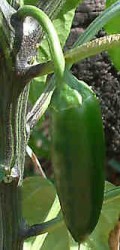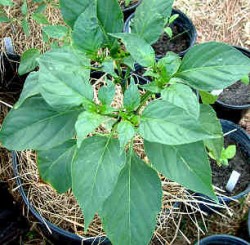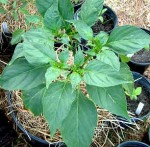Jalapenos in the Garden
Jalapenos have to be the most-recognized chile pepper around. You probably see them at the grocery store, and you’ve likely downed your share of them. But what about growing them in the garden?
The Humble Jalapeno
 You may not know this, but there are a multitude of jalapeno varieties. They all have the same basic pepper shape, but would you believe they come in different colors? Not to mention different sizes and Scoville units (“heat” to the uninitiated).
You may not know this, but there are a multitude of jalapeno varieties. They all have the same basic pepper shape, but would you believe they come in different colors? Not to mention different sizes and Scoville units (“heat” to the uninitiated).
Now most of the time the jalapenos you see and/or grow are the green peppers we all know and love. But they come in yellow and purple, too! And all varieties ripen to red (which can be fire-engine or quite deep burgundy).
How Hot — Or Not?
Yes it’s true, these versatile chile peppers come in several degrees of heat. There is the “regular” jalapeno, which is around 4,700 Scoville Units.
There’s also a “lite” variety called Tam Jalapeno that has less heat — somewhere in the vicinity of 2,000 SUs.
And for those who love these peppers but for whatever reason can’t take the heat — there is at least one variety that’s barely at 500 SUs.
To the best of my knowledge, there isn’t a super-hot jalapeno, but if you live in a warm climate, your peppers will get hotter as your weather warms up. In addition, if you let the peppers ripen to red, they are hotter yet!
Jalapenos — Does Size Matter?
You can look at this two ways — size of the pepper itself, or size of the plant.
There’s a variety called Mucho Nacho whose peppers are roughly twice the size of the standard jalapeno — great for anyone who can’t get enough of a good thing!
As far as the plants go — well, be prepared for the possibility of a large plant. Like 4 feet tall and just about as wide (yes, I’ve had them like that). That’s when they are planted in rich, well-drained soil and have plenty of warmth and at least 8 hours a day of direct sunlight.
If your soil, warmth or sunshine isn’t up to snuff, the plants will very likely be smaller; how much smaller depends on the conditions.  But 2 feet tall is a good guesstimate.
 You can also grow these chile peppers in containers (which is what I am personally doing now). A 5-gallon pot will give you plenty of peppers to pick.
You can also grow these chile peppers in containers (which is what I am personally doing now). A 5-gallon pot will give you plenty of peppers to pick.
Just make sure to keep it well-watered and fertilize it more often than you would if it were in the ground. (I like to fertilize weekly, with 1/3 to 1/2 strength liquid fertilizer — fish emulsion is my favorite.)
The plant in the picture is roughly 18 inches tall at the moment, and it’s come through some chilly weather the last month or so. But now that the weather is warming up, I expect it to grow at least another 12 inches by the time everything is said and done. For more information, check out my post on growing chile peppers in containers.
No peppers are ready for picking, but I’ve got plenty of blooms to tantalize me, knowing that most (if not all) will become a hot jalapeno.
While I don’t know for certain, I’m pretty sure this is the variety called Jalapeno M. It’s a nice open-pollinated variety that does well in most climates. If you need some tips, check out the growing chile peppers post.
Jalapeno peppers in the garden are easy to grow and quite forgiving. Give your plant(s) some care and you may end up with more peppers than you know what to do with!
Germinating Pepper Seeds, Update
It’s been just over a week since I planted my latest batch of pepper seeds, both hot and sweet. So what’s sprouting already?
And the Winner Is…
Corno di Toro, a sweet pepper, was first out of the gate at 5 days. However, of the two seeds I’ve planted, only one has shown up yet. On the other hand, I planted two different strains (confused yet?). At any rate, the red Corno di Toro is the clear winner.
Jalapeno M was the second to sprout at 6 days, with both seeds coming on up. Jalapeno M was closely followed by Cambuci Hot, about a half day behind.
The next two sprouted at nearly the same time — Nardello Sweet and Mini Belle.
And finally this morning — Mustard Habanero. Wow, a super-hot pepper in 7.5 days — amazing.
I’m Waiting On
Some “hotties” — Hot-Banero, Peter Pepper and Bhut Jolokia. Also lagging are two more jalapenos — Jaloro and Tam Jalapeno. Brazillian Rainbow is also nowhere to be seen yet. I know — patience! And considering 10 to 21 days is the usual for hot chile peppers, it’s great that some have already shown their faces (er, leaves). Yes, the seed germination mat I talked about does work well, shaving days off the sprouting.
Thinking About a Transplant
Purira pepper (quite hot) is growing very strong and looks like it will need its final transplant before going outside to harden off for the garden in the next few days. Seeing as I did its first transplant early last week, this one appears to be a winner!
Other pepper seeds that need their final transplants before hardening off include Redskin, Anconcagua and the last of the sweet banana peppers. For Sweet Pickle I just did its first transplant on Saturday, and it appears that it will need its second transplant this weekend — wow, that was fast!
More Seeds?
I think I’ll take a short break, since I have at least 20 pepper plants at the moment, not counting the ones that are just now sprouting. Come the middle of April, it will be time to start thinking about my late Summer wave. I’m planning on the following peppers for then: Datil, Tennessee Teardrop, Ring of Fire, Yellow Cayenne and Scotch Bonnet. On the cooler side it will be more Sweet Banana, along with Anconcagua and probably Nardello Sweet. Perhaps Mini Belle again, if small bell peppers work well for me.
Have You Planted Your Seeds Yet?
I know, it’s been a cold winter, and for many of you, putting pepper plants into the garden is many months away. But for you folks in zones 8, 9 and 10 — it’s pepper “prime time”. Get planting!
P.S. — it’s a few hours later and both my Corno di Toro, both Cambuci and both Mustard Habaneros are up. Even Peter Pepper is starting to break through! What a difference a few hours can make. 🙂
Chile Pepper Seeds
It’s been quite cool here in South Florida during January, and now we’re set to get more near-freezing weather this week — it doesn’t bode well for chile peppers! I’ve got one out in the garden already — Thai Hot — but none of my other chile seeds (except for Pretty Purple Pepper) have germinated. My sweet peppers, on the other hand, have pretty much all germinated fine.
Hmm.
The Need for Heat
Thinking that warmth may be the issue (it’s been awfully cool inside the house as well), I decided to spring for a new seed germination heating pad. If you’re not familiar with them, they provide a gentle heat to the bottom of the seed tray. Think of these as heating pads for seeds!
Note: you cannot use a regular “people” heating pad to warm your seeds — they are not designed to operate 24/7 and the seed germination pads are. If you use a regular heating pad, you risk starting a fire (or at the very least developing hot spots and give too much heat to the little seeds).
Now my new one is about 20″ x 10″ in size, and I can put two of my 8″ x 8″ trays on it with room to spare. I generally like only only do smaller trays, in cycles. That way, while one tray is sprouted and enjoying the grow lights, I can be starting another set.
Today’s Chile Pepper Seeds
Some of today’s seeds are new (I just bought them recently) and some are from 10 years ago — treasured seeds that I can’t help but try and grow again.
The new seeds are:Â Cambuci Hot, Jalapeno M, mustard habanero, Peter Pepper and Bhut Jolokia.
The older seeds are: Tam Jalapeno, Jaloro, Hot-Banero and Brazilian Rainbow. The last two especially, since they were both from saved seed in my garden. Hot-Banero was the absolute hottest pepper I have ever grown and Brazilian Rainbow is rare. I’d love to see how my Hot-Banero stacks up against Mustard Habanero and Bhut Jolokia!
Unfortunately, it’s going to be awhile before I really can expect any “action” from my plantings. Chile seeds seem to take quite a bit longer than sweet peppers, so I’m thinking it will be around Valentine’s Day before I see the first of the chiles popping their heads above ground.
Germinating pepper seeds isn’t really hard, except for the waiting part. But given my weather of late, I’d have to wait to plant them even if they were already sprouted and grown enough.
